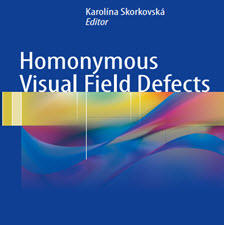Homonymous Visual Field Defects
ABSTRACT
Vision is the primary sense in humans. There are approximately one million axons in the optic nerve, constituting almost 40% of the total number of axons in all cranial nerves. The primary sensors for sight are the 130 million rods and seven million cones found in the retina. With the release of glutamate, they transform electromagnetic waves of light with a wavelength between 400 and 700 nm to graded changes of the membrane potential. The signal from photoreceptors continues to the bipolar cells and then to the retinal ganglion cells. Their axons pass through the optic nerve, the optic chiasm, form the optic tract, and reach the lateral geniculate body of the thalamus. The axons coming from the nasal hemiretina are crossed in the optic chiasm, while axons from the temporal hemiretina stay uncrossed. Neurons of the lateral geniculate body send their axons to the optic radiation and terminate in the primary visual cortex – the striate area in the ipsilateral occipital lobe where the frst analysis of visual information is performed. Further processing takes place in extrastriate visual areas in the occipital, parietal, and temporal lobes. The visual pathway shows a precise retinotopical organization at all levels that gives the anatomical background for symptoms when some part of optic pathway is damaged.
INTRODUCTION
The visual pathway is composed of four neuronal elements. Photoreceptors, bipolar cells, and retinal ganglion cells are found in the retina. Axons of ganglion cells pass through the optic nerve, optic chiasm, and optic tract. The fourth neuronal elements are found in the lateral geniculate body; their axons form the optic radiation and terminate in the primary visual cortex (Fig. 1.1). The retina is the innermost thin layer of tissue covering the back of the eye. It develops from the optic vesicles of the hindbrain. Each optic vesicle “caves in” to form the optic cup, which consists of two layers and is connected to the developing brain by the optic stalk. The outer layer of the optic cup becomes the pigment epithelium of the retina, and the inner layer differentiates into the complex neural layer of the retina. The optic stalk becomes the optic nerve. The retina is functionally divided into small spots called receptive felds, composed of the circular receptive feld centre and the peripheral area (Fig. 1.2).
چکیده
بینش حس اولیه در انسان است. حدود یک میلیون آکسون در عصب بینایی وجود دارد که تقریبا 40٪ از کل آکسون در تمام اعصاب جمجمه ای ایجاد می شود. حسگرهای اولیه برای دیدن هستند 130 میلیون میله و هفت میلیون مخروط در شبکیه یافت می شود. با انتشار گلوتامات، امواج الکترومغناطیسی نور را با طول موج بین 400 و 700 نانومتر به تغییرات درجهبندی پتانسیل غشا تبدیل می کنند. سیگنال از فتورسپتورها به سلول های دوقطبی و سپس سلول های گانگلیونی شبکیه ادامه می یابد. آکسون آنها از طریق عصب بینایی عبور می کند، چیماسی اپتیکی، دستگاه نوری را تشکیل می دهد و به بدن غده جانبی جانبی تالاموس می رسد. آکسون هایی که از hemiretina بینی تهیه می شوند در کیست های اپتیکی عبور می کنند، در حالی که آکسون ها از hemiretina temporal hemiretina بی حرکت هستند. عصب های بدن ژنیتال جانبی، آکسون هایشان را به اشعه ایکس می رسانند و در ناحیه قشر بصری اولیه قرار می گیرند – ناحیه رشته ای در لبه گوشه ی سمت راست که در آن تجزیه و تحلیل اطلاعات بصری انجام می شود. پردازش بیشتر در ناحیه های بصری بسیار چشمگیر در لبه های گوشه ای، تیری و طولانی صورت می گیرد. مسیر بصری یک سازمان دقیق رتینیتوپاتی را در تمام سطوح نشان می دهد که پس زمینه تشریحی برای علائم زمانی که بخشی از مسیر نوری آسیب دیده است را نشان می دهد.
مقدمه
مسیر بصری از چهار عنصر عصبی تشکیل شده است. Photoreceptors، سلول های دوقطبی و سلول های گانگلیونی شبکیه در شبکیه یافت می شود. Axons سلولهای گانگلیونی از طریق عصب بینایی، چینی اپتیکی و دستگاه نوری عبور می کنند. عناصر چهارگانه عصبی در بدن جنبلی جانبی دیده می شود. آکنه های آنها نور خورشید را تشکیل می دهند و در قشر دید اولیه اولیه خاتمه می یابند (شکل 1.1). شبکیه درونی ترین لایه نازک از بافت پشت چشم است. این از حاملهای اپتیکی مچ پا پیش میرود. هر ویسکوز اپتیکی “غارها” را تشکیل می دهد تا فنجان اپتیکی را تشکیل دهد که شامل دو لایه است و با پایه نوری به مغز در حال توسعه متصل می شود. لایه بیرونی فیبر نوری به اپیتلیوم رنگدانه شبکیه تبدیل می شود و لایه داخلی آن را به لایه عصبی پیچیده شبکیه متمایز می کند. پایه نوری عصب بینایی است. شبکیه به صورت کارکردی به لکه های کوچک به نام فضاهای گیرنده تقسیم شده است که از مرکز گیرنده دایره ای و منطقه محدوده تشکیل شده است (شکل 1.2).
Year: 2016
Publisher: SPRINGER
By : Karolína Skorkovská
File Information: English Language/ 186 Page / size: 11.75 MB
Only site members can download free of charge after registering and adding to the cart
سال : 1395
ناشر : SPRINGER
کاری از : Karolína Skorkovská
اطلاعات فایل : زبان انگلیسی / 186 صفحه / حجم : MB 11.75
[sdfile url =”http://dl.taliem.ir/book/pezeshki/Homonymous.Visual.Field.Defects-taliem.ir.rar”]




![Keratoconus.Recent.Advances.in.Diagnosis.[taliem.ir]](https://taliem.ir/wp-content/uploads/Keratoconus.Recent.Advances.in_.Diagnosis.taliem.ir_-150x150.jpg)

دیدگاه خود را ثبت کنید
تمایل دارید در گفتگو شرکت کنید؟نظری بدهید!